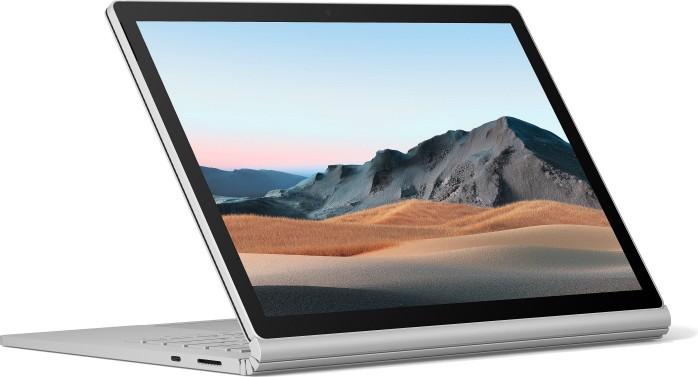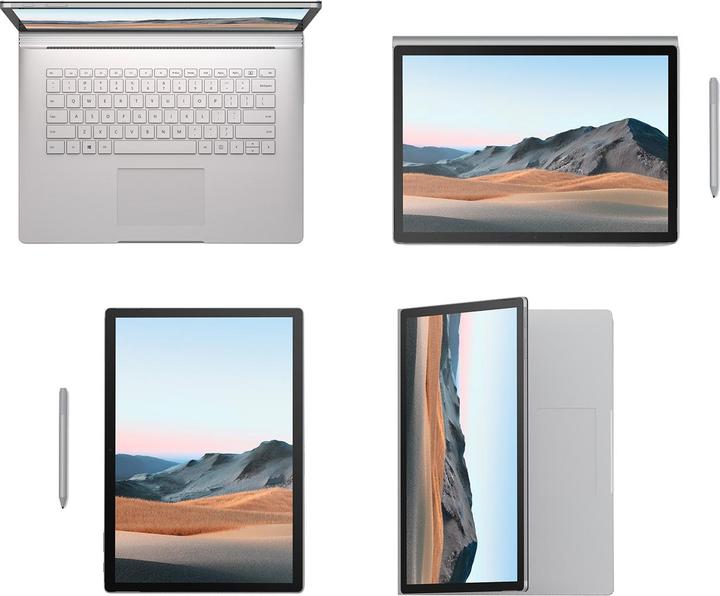

Microsoft Surface Book 3 tested three times: 10th Gen Intel and nVidia graphics power
Three Surface Book 3s, two with i7 and nVidia graphics power, one with i5 and nothing else. Even without cooling. What can they do? They are supposed to be all-rounders. Tablet, notebook and gaming box in one. This test shows how well that works.
Are Microsoft convertibles such as the Surface Pro 7 or Go 2 too small or too wobbly because of the stand or the thin keyboard? Then you can opt for a Surface Laptop or a Surface Book. With a Book, you get the stability of a laptop plus the option of using the device as a tablet.
The Surface Book 3 is available in 13.5 and 15 inches. If you opt for the more compact version, you have the choice between one without or with a dedicated graphics card - an nVidia GeForce GTX 1650 Max-Q. This is installed under the keyboard in the base, where most of the battery cells are also located. The 15-inch models all have an nVidia GeForce GTX 1660 Ti Max-Q.
In addition to the size and graphics power, the different versions also differ in terms of processors, available RAM and SSD memory as well as battery capacity.
13.5" Microsoft Surface Book 3
15" Microsoft Surface Book 3
For this review, I'm grabbing the cheapest 13.5-inch book with i5, without a dedicated graphics card. Also a small and large version each with nVidia graphics power. The three have the following specifications:
| MS SB3 13,5” i5
8 GB | MS SB3 13,5” i7
32 GB, GTX 1650 Max-Q | MS SB3 15” i7
16 GB, GTX 1660 Ti Max-Q | |
|---|---|---|---|
| Prozessor | Intel Core i5-1035G7 | Intel Core i7-1065G7 | Intel Core i7-1065G7 |
| Grafikkarte | Intel Iris Plus Graphics | nVidia GeForce GTX 1650 Max-Q (und Intel Iris Plus Graphics) | nVidia GeForce GTX 1660 Ti Max-Q (und Intel Iris Plus Graphics) |
| Arbeitsspeicher | 8 GB LPDDR4 SDRAM | 32 GB LPDDR4 SDRAM | 16 GB LPDDR4 SDRAM |
| Datenspeicher | 256 GB SSD | 512 GB SSD | 256 GB SSD |
| Display | 13.5” IPS Multi-Touch, 3000 x 2000 Pixel (267 ppi, hochglanz, unterstützt Stifteingabe) | 13.5” IPS Multi-Touch, 3000 x 2000 Pixel (267 ppi, hochglanz, unterstützt Stifteingabe) | 15” IPS Multi-Touch, 3240 x 2160 Pixel (260 ppi, hochglanz, unterstützt Stifteingabe) |
| Anschlüsse | 2 x USB 3.1 Typ-A, 1 x USB 3.1 Typ-C (Video, Power in/out, Data), 2 x Netzanschluss (Surface Connect), SDXC Card Reader (Full-size, UHS-II) | 2 x USB 3.1 Typ-A, 1 x USB 3.1 Typ-C (Video, Power in/out, Data), 2 x Netzanschluss (Surface Connect), SDXC Card Reader (Full-size, UHS-II) | 2 x USB 3.1 Typ-A, 1 x USB 3.1 Typ-C (Video, Power in/out, Data), 2 x Netzanschluss (Surface Connect), SDXC Card Reader (Full-size, UHS-II) |
| WLAN, Bluetooth | Wi-Fi 6, Bluetooth 5.0 | Wi-Fi 6, Bluetooth 5.0 | Wi-Fi 6, Bluetooth 5.0 |
| Audio | 3.5-mm-Klinkenanschluss, Stereo-Lautsprecher, Dualmikrofon | 3.5-mm-Klinkenanschluss, Stereo-Lautsprecher, Dualmikrofon | 3.5-mm-Klinkenanschluss, Stereo-Lautsprecher, Dualmikrofon |
| Sensoren | Umgebungslichtsensor, Näherungssensor, Beschleunigungssensor, Gyroskop, Magnetometer, Windows Hello Kamera (Gesichtserkennung) | Umgebungslichtsensor, Näherungssensor, Beschleunigungssensor, Gyroskop, Magnetometer, Windows Hello Kamera (Gesichtserkennung) | Umgebungslichtsensor, Näherungssensor, Beschleunigungssensor, Gyroskop, Magnetometer, Windows Hello Kamera (Gesichtserkennung) |
| Kamera | 5-Mpx-Front- und 8-Mpx-Rückkamera | 5-Mpx-Front- und 8-Mpx-Rückkamera | 5-Mpx-Front- und 8-Mpx-Rückkamera |
| Akku | 69 Wh Lithium-Ionen-Akku (davon 18 Wh im Tablet) | 73 Wh Lithium-Ionen-Akku (davon 18 Wh im Tablet) | 82 Wh Lithium-Ionen-Akku (davon 22,3 Wh im Tablet) |
| Betriebssystem | Windows 10 Home | Windows 10 Home | Windows 10 Home |
| Dimensionen | 31,2 x 23,2 x 1,3-2,3 cm, 1,53 kg | 31,2 x 23,2 x 1,5-2,3 cm, 1,64 kg | 34,3 x 25,1 x 1,5-2,3 cm, 1,91 kg |
| Netzteil | 65 W | 102 W | 127 W |
Unfortunately, the third version of the Surface Book still doesn't come with a Thunderbolt port. Instead, the RAM has been changed from LPDDR3 to LPDDR4 and thanks to the 10th Gen Intel SoC, Wi-Fi 6 and Bluetooth 5.0 are now also included.
Design and connections: Accordion hinges turn the Book into a Book
The platinum-coloured magnesium casing not only looks great, I also like to touch it - I like it cool and metallic. The Surface Book's base with keyboard looks like it's made from a single mould. In contrast to the Surface Pro and Go, this Microsoft convertible not only offers additional battery capacity, but also more graphics power if required. A thin plug-in keyboard is not included here. Instead, you get a solid base and a display that can be separated and operated as a tablet at the touch of a button.
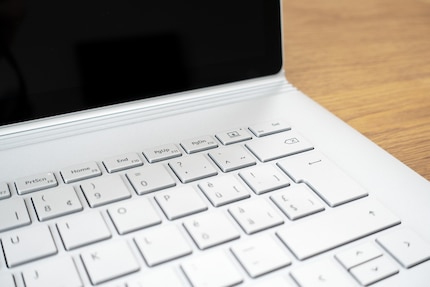
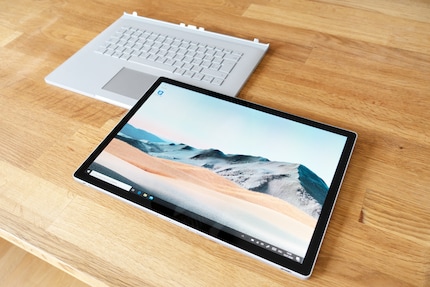
But that's not all; you can also insert the tablet into the base upside down. Of course, you will then have to do without the physical keyboard. However, any conceivable display angle is possible. This is an advantage in various situations. For example, if you want to write or draw notes with a pen, which must be purchased separately. In addition, the dedicated graphics card can only be used when the base is plugged in. If you disconnect the display, Windows switches to the graphics unit integrated on the SoC.
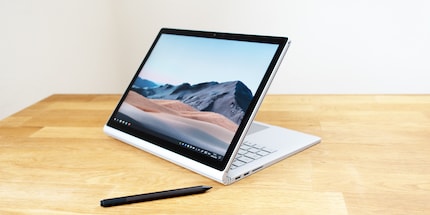
Without the base, the 15-inch tablet weighs 818 grams. The difference to the 13.5-inch tablet is not noticeable. The latter weighs 718 grams.
From the side, the Surface Book has a gap where the display of other laptops lies flush with the base. When I ask those around me about the design, opinions differ. It feels like half of them like it or find it less attractive. Regardless of whether they like the design, what can be said with certainty is that the mechanics behind the features are robust. Both the mechanism that connects the display to the base and the accordion hinges for tilting the display, which make the book look like a book.
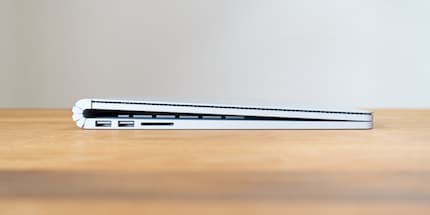
Two USB 3.1 ports (Type-A) and a full-size SDXC card reader (UHS-II) are located on the left side of the book.
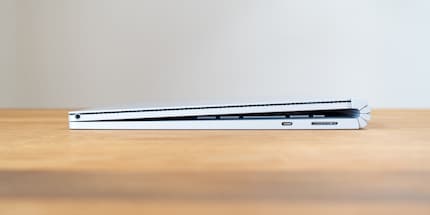
On the right are USB 3.1 Type-C and the Surface Connect port (power connection). Incidentally, there are two of these on the device. The second is located on the underside of the display. This means the tablet can also be charged without a base. There is also a 3.5 mm jack connection on the right of the display. The power button and volume rocker are located at the top left of the tablet.
Multitouch in 3:2 format: This is how good the built-in displays are
The 10-point multi-touch displays with a 3:2 aspect ratio and IPS technology have not changed in terms of resolution compared to their predecessor. Which I can understand, because at 3000×2000 and 3240×2160 pixels respectively, the displays are sufficiently sharp. Even when I move my face closer when drawing with a pen.
I find the colour reproduction on all models to be accurate. But my perception can also be wrong, which is why I want to know exactly. How good are the displays, how bright are they and how balanced is the uniformity of the illumination? To find out, I measure them with the x-rite i1Display Pro Plus.
13.5-inch display of the i5 book under the magnifying glass
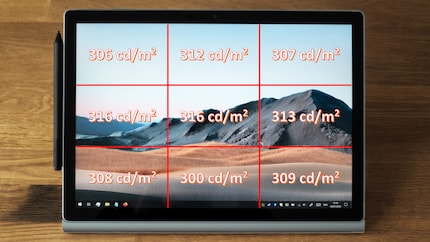
With an average of 310 cd/m², the display is bright enough to work in the shade in most lighting conditions. Reflections or direct sunlight should always be avoided with a high-gloss display. Incidentally, the uniformity of the illumination is strikingly accurate. The difference between the brightest and darkest measuring points is only 16 cd/m². I would like to point out that each panel is unique - even in comparison to its model siblings - and deviations in the lighting can occur accordingly.
In terms of colour space coverage, I measured 94.5 per cent for sRGB, 65.7 per cent for Adobe RGB and 67.5 per cent for DCI P3. The display is unlikely to be suitable for the professional creation or preparation of print content. However, it is perfectly suitable for hobby creatives and for creating web content. Thanks to the IPS panel, the colours look natural, but still sufficiently rich. When I measure the black and white values, I calculate a good static contrast of 1225:1.
#
13.5-inch display of the i7 book under the magnifying glass
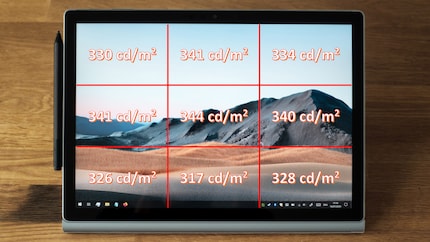
Although the panel of the 13.5-inch i7 variant presumably comes from the same production line, it shines slightly brighter with an average of 333 cd/m². The biggest drop in light is from the centre to the bottom and is 27 cd/m².
With an accuracy of 93 per cent for SRGB, 64.3 per cent for Adobe RGB and 66.2 per cent for DCI P3, the panel performs slightly worse than the i5 variant tested above. The static contrast is 1291:1.
15-inch display under the magnifying glass
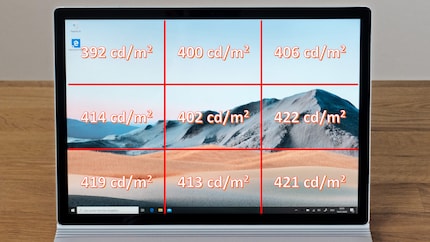
Bigger does not automatically mean better. However, the 15-inch panel provides 80 or 100 cd/m² more luminosity. With an average of 410 cd/m², anyone for whom 310 cd/m² is not enough will be happy. This display has an advantage in bright light conditions. However, the uniformity of the illumination is minimally worse - the illumination drops by 29 cd/m² from the bottom right to the top left. A relatively small value that is difficult or even impossible to see with the naked eye.
The larger display loses out in the colour space coverage measurements. With 87.5 per cent for sRGB, 60.5 per cent for Adobe RGB and 62.2 per cent for DCI P3, it is even less suitable for polygraphers and graphic designers. However, the static contrast of 1475:1 is somewhat crisper.
Keyboard and trackpad
The three-stage backlit keyboard is identical on both models. And it surprised me positively.
I've got used to the fact that it's become a trend to install keyboards with minimal keystroke depth in notebooks. But it's really refreshing, almost nostalgic, to feel 1.55 millimetres under your fingers again. When pressed, the keys feel rather firm and have a clearly perceptible trigger point. The response speed is top notch, my 10-finger system works like a charm.
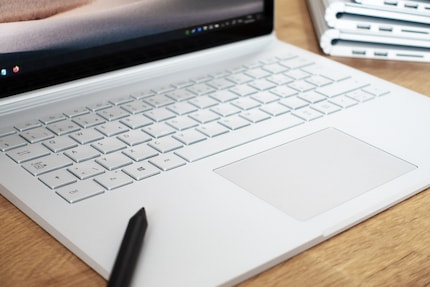
I have nothing to criticise about the glass trackpad with multi-finger gesture support. It's nice and large and everything works smoothly. But it's not too big. When typing, the palm of my hand doesn't rest on it, but next to it. I'm grateful for that. Only an Apple fanatics - trackpads on MacBooks are huge - or someone with extreme, if not the most extreme, sausage fingers would not enjoy this device. Bravo, I'm a fan of design based on usability considerations.
Speakers with Dolby and all that
At first glance, the stereo speakers attached to the side of the display on all models sound identical. However, the display of the 15-inch device offers a larger resonance body, which makes the bass sound minimally richer. Which would be nice if there wasn't a problem with this (?), which I can perceive with two identical 15-inch models: The sound clearly rattles with that noise that always comes when you want to install a new programme. These already annoying attention tones now sound tinny and even more annoying. I wouldn't have noticed this if it weren't for the signalling tone sequence. Everything sounds clean on the 13.5-inch devices.
Music and films are a pleasure by mobile standards with all devices. The sound is wider than the distance between the speakers. The mids and highs are clean. As with all notebooks and tablets, deep bass lacks what subwoofers can do.
Battery performance
Microsoft has given the i5 13.5-inch book a 69 Wh and the i7 a 73 Wh lithium-ion battery, which is divided into six cells. The tablet contains 18 Wh of the total capacity in each case. The tablet part of the 15-inch version contains 22.3 Wh out of a total of 82 Wh, which is distributed across eight cells. It all sounds generous. Let's see if the devices have good energy management. I'm testing it while continuously streaming YouTube videos, at maximum performance and during office work.
Continuous YouTube streaming
To ensure comparability with our other reviews, I set the brightness of the displays to 150 cd/m² before starting the test. Now I run music videos on YouTube until the energy reserves are depleted. During testing, I notice that the Books with a dedicated graphics card run correctly with the integrated Intel Iris Plus Graphics. This saves energy.
The first book to run out of juice is the i5 13.5-inch version. After six hours and 52 minutes, the battery capacity is down to two per cent, whereupon Windows shuts itself down. Six minutes later, after six hours and 58 minutes, the small i7 Book also shuts down. With the 15-inch book, seven hours and 47 minutes are possible. These are decent values - they match the given battery capacity and power-hungry nature of the installed hardware. As a comparison, a current Apple MacBook Pro 16 with ninth-generation i7 SoC and almost 100 Wh battery achieves nine hours in the same YouTube test with 150 cd/m². The Microsoft Surface Pro 7 with 10th Gen i5 and 12.3-inch display and 45 Wh capacity achieved five hours and 16 minutes.
Nothing should stand in the way of enjoying a long film in a darkened room.
Battery life under maximum performance
To push all the hardware to its limits, I run the stress test HeavyLoad and FurMark simultaneously with the screen set to maximum brightness.
The stress test shows that the i5 version is only passively cooled. The device doesn't make a sound. The i7 books emit a quiet, barely audible noise. After 10-15 minutes, it becomes an audible noise on both. From my sitting position, i.e. at around an arm's length from the display, I measured 41 dB on the smaller and 52 dB on the larger - and it remained at this level until the end of the test. That's no louder than the background noise of a quiet residential neighbourhood or park.
The following table with information on time, battery status and CPU utilisation shows how well the active and passive cooling of the books works. The graphics cards (dedicated and integrated) are always fully utilised during the test, except for small deviations in the single-digit range, which is why they are not listed. All changes in CPU utilisation as well as the times and remaining battery capacity every half hour are highlighted in bold in the table.
| Vergangene Zeit | MS SB3 13,5” i5
8 GB | MS SB3 13,5” i7
32 GB, GTX 1650 Max-Q | MS SB3 15” i7
16 GB, GTX 1660 Ti Max-Q |
|---|---|---|---|
| 0 Minuten | 100% Akkukapazität
100% CPU-Auslastung | 100% Akkukapazität
100% CPU-Auslastung | 100% Akkukapazität
100% CPU-Auslastung |
| 34 Sekunden | CPU fällt und schwankt bei 46-55% | 100% CPU-Auslastung | 100% CPU-Auslastung |
| 1 Minute | 46-55% CPU-Auslastung (schwankend) | 100% CPU-Auslastung | CPU fällt auf 93% |
| 5 Minuten | 46-55% CPU-Auslastung (schwankend) | CPU fällt und schwankt bei 93-100% | 93% CPU-Auslastung |
| 8 Minuten | 46-55% CPU-Auslastung (schwankend) | 93-100% CPU-Auslastung (schwankend) | CPU fällt auf 92% |
| 14 Minuten | 46-55% CPU-Auslastung (schwankend) | CPU fällt und schwankt bei 71-78% | 92% CPU-Auslastung |
| 15 Minuten | CPU bleibt bei 53% | 71-78% CPU-Auslastung (schwankend) | 92% CPU-Auslastung |
| 20 Minuten | 53% CPU-Auslastung | 71-78% CPU-Auslastung (schwankend) | CPU fällt auf 91% |
| 21 Minuten | 53% CPU-Auslastung | CPU fällt und schwankt bei 67-73% | 91% CPU-Auslastung |
| 30 Minuten | 85% Akkukapazität
53% CPU-Auslastung | 76% Akkukapazität
67-73% CPU-Auslastung (schwankend) | 68% Akkukapazität
91% CPU-Auslastung |
| 49 Minuten | 53% CPU-Auslastung | 67-73% CPU-Auslastung (schwankend) | CPU fällt auf 58% |
| 51 Minuten | 53% CPU-Auslastung | 67-73% CPU-Auslastung (schwankend) | CPU fällt auf 53% |
| 56 Minuten | 53% CPU-Auslastung | 67-73% CPU-Auslastung (schwankend) | CPU fällt auf 49% |
| 60 Minuten | 70% Akkukapazität
53% CPU-Auslastung | 51% Akkukapazität
67-73% CPU-Auslastung (schwankend) | 39% Akkukapazität
49% CPU-Auslastung |
| 67 Minuten | 53% CPU-Auslastung | CPU fällt und schwankt bei 59-64% | CPU fällt und schwankt bei 46-49% |
| 71 Minuten | 53% CPU-Auslastung | 59-64% CPU-Auslastung (schwankend) | CPU fällt und bleibt bei 46% |
| 74 Minuten | 53% CPU-Auslastung | CPU fällt und schwankt bei 54-57% | 46% CPU-Auslastung |
| 87 Minuten | 53% CPU-Auslastung | CPU fällt und bleibt bei 51-53% (schwankend) | 46% CPU-Auslastung |
| 90 Minuten | 54% Akkukapazität
53% CPU-Auslastung | 27 % Akkukapazität
51-53% CPU-Auslastung (schwankend) | 11% Akkukapazität
46% CPU-Auslastung |
| 103 Minuten | 50 % Akkukapazität
53% CPU-Auslastung | 18 % Akkukapazität
51-53% CPU-Auslastung (schwankend) | 2% Akkukapazität –
Auto Shutdown 46% CPU-Auslastung |
| 120 Minuten | 44 % Akkukapazität
53% CPU-Auslastung | 3 % Akkukapazität
51-53% CPU-Auslastung (schwankend) | |
| 121 Minuten | 44 % Akkukapazität
53% CPU-Auslastung | 2% Akkukapazität –
Auto Shutdown 51-53% CPU-Auslastung (schwankend) | |
| 150 Minuten | 29 % Akkukapazität
53% CPU-Auslastung | ||
| 180 Minuten | 16 % Akkukapazität
53% CPU-Auslastung | ||
| 208 Minuten | 2% Akkukapazität –
Auto Shutdown 53% CPU-Auslastung |
For almost 50 minutes, the cooling manages to keep the processors of the 15-inch book at over 90 per cent utilisation. It then drops rapidly to 58 per cent and gradually further before remaining at 46 per cent after 71 minutes. The automatic shutdown takes place after 103 minutes.
Not only the aforementioned quieter noise of the fan, but also the behaviour of the CPU load show that the 13.5-inch variant with i7 and dedicated graphics card has less good cooling - smaller dimensions, that is. The CPU only stays above 90 per cent for 14 minutes. After that, the utilisation fluctuates around 70 per cent before it reaches the 50 per cent brand again after 67 minutes and remains at 51-53% from minute 87. The device shuts down after 121 minutes.
Without active cooling, the CPU utilisation of the i5 processor in the smaller Book drops to around half after just 34 seconds. It then fluctuates between 46 and 55 per cent and remains at 53 per cent after 15 minutes. It's not surprising that it doesn't run out of steam until after 208 minutes. The reduced CPU performance and the lack of a dedicated graphics card lead to longer runtimes during the test.
I am satisfied with the actively cooled books. Their i7 processor can also offer high clock rates for longer periods, i.e. for almost 15 minutes or 50 minutes as in the 15-inch book. The passively cooled i5, on the other hand, can't even flex its muscles for nearly a minute.
Battery life for office work
If I refrain from excessive video chat meetings or gaming in the office, which would put a strain on the dedicated graphics card, the battery of the 15-inch notebook easily lasts a working day. It lasts ten to eleven hours. Nevertheless, it's not a bad idea to have the power supply unit with you. When I'm working in the fresh air, I like to set the display to the brightest level, which consumes more energy. With the batteries of both 13.5-inch books, I get nine to ten hours of battery life in office mode.
CPU and graphics processor
The Intel Core i5-1035G7 in the 13.5-inch book is an energy-efficient quad-core SoC for notebooks and convertibles. It was launched on the market in autumn 2019 and belongs to the Ice Lake generation, which is manufactured using Intel's new 10 nm process (2nd generation). Using all four cores (eight threads), the i5-1035G7 clocks at 1.2 to 3.3 GHz. If only two cores are used, it can be clocked up to 3.6 GHz - with one core even up to 3.7 GHz. The cores called Sunnycove should be able to process 18 per cent more IPCs (instructions per clock) than their Whiskey Lake predecessors. This should enable the CPU to achieve the same performance as its i5 predecessor despite a lower clock rate. The chip also features Intel's Iris Plus Graphics G7 (Gen 11). It offers 64 shader clusters at 300-1100 MHz.
The second 13.5-inch and the 15-inch book feature the mobile quad-core SoC Intel Core i7-1065G7 - also with Ice Lake architecture. It also offers four cores or eight threads with a base clock speed of 1.3 GHz. Up to two cores can be boosted to 3.9 GHz via Turbo. Using four cores, 3.5 GHz is possible. The Iris Plus Graphics G7 is also included here as the graphics unit. The power consumption of the processors can be configured by the manufacturer to up to 25 watts. The values described here refer to a standard version with 15 watts TDP.
Graphics cards
In addition to the dedicated Intel graphics on the SoC, an nVidia GeForce GTX 1660 Ti Max-Q is also installed in the 15-inch book. This is located in the lowest high-end range and is based on the Turing architecture (TU116 chip). Compared to the faster RTX 2000 GPUs, it has no integrated ray tracing or tensor cores. Instead, it has 1536 shader units. It is manufactured using the 12 nm process. It employees at a frequency of 1140 to 1335 MHz and has 6 GB GDDR6 video RAM (connection via 192-bit interface). The power consumption is normally 60 watts.
The nVidia GeForce GTX 1650 Max-Q in the 13.5-inch book is slightly weaker. It differs in that it only has 1024 shader units. Furthermore, the frequency is lower at 1020 to 1245 MHz and it only has 4 GB of video RAM. Its power consumption is 30 watts.
Performance: What the Surface Book hardware can do
To test the performance, I run various tests; Cinebench R20 and Geekbench 5 for the processors as well as some 3DMark benchmarks to get a feel for the GTX 1660 Ti Max-Q and the GTX 1650 Max-Q.
Processor performance: Cinebench R20 and Geekbench 5
With Cinebench from Maxon, you can test how your PC performs when rendering Cinema 4D content. Processors with more cores will always deliver a better result here (except for single-core results). If you want to compare processors with Cinebench, this is only possible if both processors have the same number of threads. And this is what the tested SoCs do.
Geekbench is a benchmark that runs on Windows, MacOS, Linux, Android and iOS. In addition to simulated real-world scenarios with which the CPU is tested (single-core and multi-core), Geekbench can also determine GPU performance in the areas of image processing and machine vision. You can also compare the results with other systems thanks to the Geekbench browser.
Here are the results from Cine- and Geekbench:
| MS SB3 13,5” i5
8 GB | MS SB3 13,5” i7
32 GB, GTX 1650 Max-Q | MS SB3 15” i7
16 GB, GTX 1660 Ti Max-Q | |
|---|---|---|---|
| Cinebench R20 – CPU Multi Core | 1167 Punkte | 1188 Punkte | 1494 Punkte |
| Cinebench R20 – CPU Single Core | 395 Punkte | 418 Punkte | 448 Punkte |
| Geekbench 5 – CPU Multi Core | 3400 Punkte | 4455 Punkte | 4786 Punkte |
| Geekbench 5 – CPU Single Core | 1065 Punkte | 1268 Punkte | 1247 Punkte |
| Geekbench 5 – GPU OpenCL
(Grafikbenchmark) | 8283 Punkte | 37 374 Punkte | 59 576 Punkte |
| Geekbench 5 – GPU Vulkan
(Grafikbenchmark) | 8092 Punkte | 30 944 Punkte | 46 025 Punkte |
| Geekbench 5 – GPU CUDA
(Grafikbenchmark) | - | 38 354 Punkte | 61 939 Punkte |
Looking at the Cinebench results, I think the single-core performance of the passively cooled small and large books is okay. The third book in the group is a little out of line. However, all of the books should perform better when all of the cores are utilised. Just one look at the Surface Pro 7 with Intel Core i5-1035G4 shows that it is possible, as it achieves 1504 multi-core points (and 361 single-core points) in Cinebench R20.
The i7 of the small book performs better in Geekbench 5. However, the i5 of the Surface Pro 7 also has an advantage. This comes very close to the i7 tested here and achieves 4430 multi-core points and 1230 single-core points.
Graphics performance: 3DMark benchmarks
3DMark offers lots of benchmarks for testing gaming PCs and laptops. To give you an overview of the hardware performance of the books with graphics cards, I test 1080p gaming (Fire Strike), WQHD gaming (Time Spy) and UHD gaming (Time Spy Extreme).
| Benchmark | Auflösung und DirectX-Version | Resultat MS SB3 13,5” i7
32 GB, GTX 1650 Max-Q | Resultat MS SB3 15” i7
16 GB, GTX 1660 Ti Max-Q |
|---|---|---|---|
| Fire Strike | 1920 x 1080 Pixel, DirectX 11 | 6732 Punkte
Siehe: https://www.3dmark.com/3dm... | 11 130 Punkte
Siehe: https://www.3dmark.com/3dm... |
| Time Spy | 2560 x 1440 Pixel, DirectX 12 | 2993 Punkte
Siehe: https://www.3dmark.com/3dm... | 4916 Punkte
Siehe: https://www.3dmark.com/3dm... |
| Time Spy Extreme | 3840 x 2160 Pixel, DirectX 12 | 1298 Punkte
Siehe: https://www.3dmark.com/3dm... | 2177 Punkte
Siehe: https://www.3dmark.com/3dm... |
Even if the book design of the devices looks like anything but gaming and even if the displays with their 60 Hz are not suitable for all games; you can game with these things. A little better with one of them, as the different results show. According to the 3DMark website, the performance of the smaller book is somewhere between a current office and gaming laptop. The larger one just doesn't pass as a gaming laptop.
A further comparison is a Lenovo Legion tested last October. It offers a ninth-generation i7 processor, which, however, has 6 cores and, according to userbenchmark.com has 17 per cent more performance than this one. But the graphics card is almost identical. A mobile nVidia GeForce GTX 1660 Ti without Max-Q design. This means that it is clocked slightly higher. It employees at around 20 per cent higher frequency of 1455 to 1590 MHz instead of 1140 to 1335 MHz. The Lenovo Legion achieves 12,638 points, 5668 points and 2535 points in the same tests. Around 20 per cent more performance.
Gaming and FPS
Finally, I also test the performance when gaming. With the in-game benchmark of Far Cry 5.
For Far Cry 5, the benchmark only reflects a real game to a limited extent, as there are no quick turns like those that occur when playing with the mouse. However, comparisons can be made with notebooks that have already been tested. I set the graphics quality to the highest possible level at 1080p resolution.
Far Cry 5 with Intel Core i7-1065G7 and nVidia GeForce GTX 1650 Max-Q:
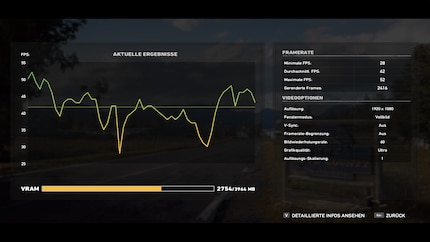
Far Cry 5 with Intel Core i7-1065G7 and nVidia GeForce GTX 1660 Ti Max-Q:
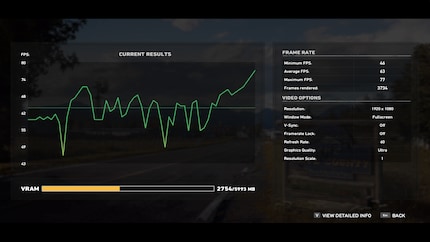
With an average frame rate of 42, the GTX 1650 Max-Q performs decently. The minimum FPS does not fall below 28 in the benchmark, so the second-highest quality level at 1080p should be targeted for Far Cry 5 when playing games where you sometimes turn quickly.
The GTX 1660 Ti Max-Q achieves an average of 63 FPS with a minimum frame rate of 46. The Lenovo Legion with 1660 Ti without Max-Q design and 17 per cent more powerful processor can also be used as a comparison here. It achieves a minimum of 72 and an average of 87 FPS.
Conclusion: If you have the money...
Microsoft knows how to take what's good and make it even better. The Surface Book 3 is appealing, has a great display, a large battery and is superbly finished. It is easy to operate or scribble on with the keyboard and trackpad, with your fingers or the pen. It also scores more points for being a notebook than other convertibles can. In laptop mode, this device is not just a tablet with a keyboard extension, but a stable device that doesn't wobble or slip away when you use it on your lap on the train. As a tablet, it does its job well, but you have to make do with a relatively small battery without a base.
What I still can't understand is why Microsoft doesn't actively cool its devices with i5 processors. The processor doesn't even manage to be fully utilised for 40 seconds. The i7 processor, on the other hand, manages to deliver 90 per cent CPU performance and more over a longer period of time. The small one achieves 14 minutes, the large one almost 50 minutes. Nevertheless, the cooling of these devices has potential for improvement, as the comparison with the in-house Pro 7 makes clear. The graphics performance, on the other hand, seems to have fewer problems with cooling. It is sufficient to play a shooter in decent quality. However, it is annoying that the displays only have 60 Hz.
If Microsoft's books weren't so expensive, I could highly recommend these devices. But since the world offers a range of notebooks with the same or better hardware for the given price, I have to turn my head in the direction of Zurich's Gold Coast before I make a purchase recommendation. Admittedly, you have to look hard to find a well-built 2-in-1 device with similar specs. These books do have their appeal.
I find my muse in everything. When I don’t, I draw inspiration from daydreaming. After all, if you dream, you don’t sleep through life.
These articles might also interest you

Product test
Reviewing the Microsoft Surface Pro 9: fresh colours and CPUs, but no headphone jack
by Martin Jud

Product test
Microsoft Surface Laptop Studio 2 tested: seductive, expensive, with room for improvement
by Martin Jud

Product test
Fanless, purple 12-inch Microsoft Surface Pro review: generally good, but…
by Martin Jud
